Growths on the paws of chickens - causes, symptoms and treatment of knemidocoptosis
Movement plays an important role in the life of chickens in cage and floor housing in a hen house, ensuring the health and optimal performance of the herd.
However, sometimes the movement of the bird causes discomfort, which is formed when the layer located under the horny covering on the skin of chickens is affected. In appearance, these places are seals containing keratinized structures that appear on the leg area not covered with feathers. Such formations of growths on the paws of chickens cause painful sensations during the movement of the bird, while the parasite, passing through the stages of the life cycle, digs passages under the surface of the skin, where larvae develop, which causes the chickens to feel unbearable itching.
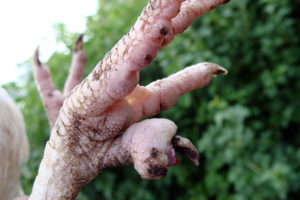
This pathology (growths on the paws) belongs to the category of infectious diseases and has the ability to actively spread among the livestock. Timely detection of the disease and therapy in the early stages is characterized by a high probability of complete elimination of the pathology.On the other hand, the loss of control over the situation can lead to the loss of the entire livestock, which occurs when the number of infected individuals reaches a critical level.
Content
Why growths form in chickens on their legs (feet): description, causes, symptoms and methods of treating the disease
The appearance of mites of the Knemidocopt type, which gave the name of the disease in chickens (Knemidocoptosis), has seasonal characteristics. Experts note activation of the parasite in late spring-early summer and the first month of autumn, preferring small chicken coops. Good conditions for the appearance of a tick provide the presence of darkened places in the bird habitat and an unbalanced diet for chickens. Having an oval or round shape, gray or yellow color and small size in the range of 0.1 - 0.47 mm, the parasite settles under the surface of the horny cover on the paws of the bird. Incubation period, during which the parasite "assimilates" in the host's body is 3-6 months. Breaking through the passages, over time, the tick reaches the epithelial tissues located under the scales, where it produces offspring.
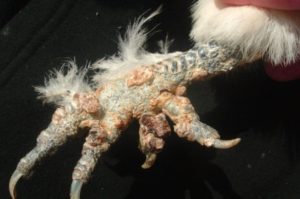
Important! Some experts believe that this type of mite does not lay eggs, the females of the parasite belong to the group of viviparous organisms and when puberty occurs, which occurs at 3-4 weeks, during a life that lasts from several weeks to a couple of months, up to 10 larvae give birth ...
As a food parasite can use:
- exudate resulting from inflammatory processes;
- epidermal cells;
- lymphatic fluid.
The most susceptible to the appearance of growths on the legs, according to the observations of farmers, are chickens between the ages of 5-7 months and older.
Note! Gnawing and breaking through passages in the area of residence, the scabies mite not only pollutes them with toxins, which are waste products of its vital activity, but also creates favorable conditions for the local penetration of other pathogenic forms into the body.
The growth of growths on the paws of chickens is associated with the development and increase in the size of the parasite larvae, and the appearance of exudate in the area of damage indicates the course of the inflammatory process. Tumor appears as a result of mechanical damage to the subcutaneous layer of a bird, which accompanied by:
- itching;
- weakening of immunity and depletion of the animal;
- dermatitis;
- the withering away of toes in chickens;
- rheumatic manifestations.
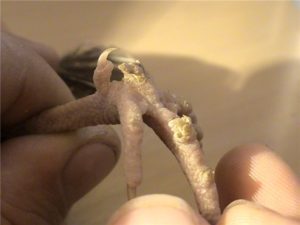
The development of the disease includes the appearance of growths, symptoms and damage by the bird's beak to areas of discomfort. After that, a film appears at the site of the violation of the integrity of the skin, and scales are formed that do not fit tightly to the skin, which can later increase in thickness or acquire a layered structure. At the same time, there may be a change in the color of the scales, their acquisition of a white-gray tint, cracks may appear in some places.
Note! Lack of treatment for growths on the legs leads to necrosis of the toes in chickens with their subsequent loss and the development of lameness. At this stage, when kept by an inattentive owner, the life of the bird is under serious threat, since the body is weakened by the presence of the parasite, and the herd, seeing an unhealthy individual, limits its access to food and water.
Timely determine the presence of growths in chickens, you can use such featured, as:
- the presence of causeless anxiety in the chicken, unwillingness to go to the chicken coop;
- detection of growths and injuries on the legs that have an ugly shape;
- the presence of pecked areas on the paws of birds;
- examination of the scales on the paws allows you to detect elements covered with a coating of white color, with a layered structure.
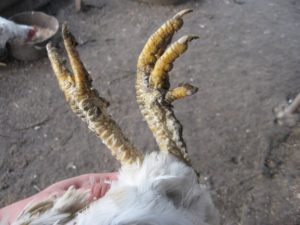
Growths in chickens on their legs are formed in the presence of favorable conditions, for example: in case of violation of sanitary conditions, feeding regimen, in case of deviation from the optimum humidity in the body of birds with reduced immunity or against the background of vitamin deficiency. For the timely detection of pathology and facilitating its course, farmers are recommended to periodically examine the paws of chickens.
How to treat growths on the legs (feet) of chickens
The appearance of growths on the legs of chickens indicates the active phase of the course of the disease, in which the bird itself becomes an active spread of infection in the form of larvae on the surface of inventory items, drinkers and other surfaces, ensuring infection of the entire livestock. To prevent the development of events in such a scenario, the farmer should pay attention to the peculiarities of the behavior of the chickens, conducting periodic inspection of the livestock.
Important! Having found a sick individual, it should be placed in an isolated room in quarantine, using medications and folk remedies to eliminate pathology.
Among the means used in the classical treatment of growths on the paws of chickens and veterinary drugs, anti-mite group medicines should be noted:
- 1% ectomin solution is a concentrated emulsion containing 1 ml of synthetic-type pyrethroid active ingredient in 1 liter of water;
- trichlorometaphos 0.4% concentration is a systemic insecticide, is highly effective in the contact method of use;
- butox contains deltamethrin, refers to universal drugs for the treatment of dermatological pathologies, is used after diluting 10 ml of the product in 1.3 liters of water with a repetition of treatment if necessary after 1.5 weeks;
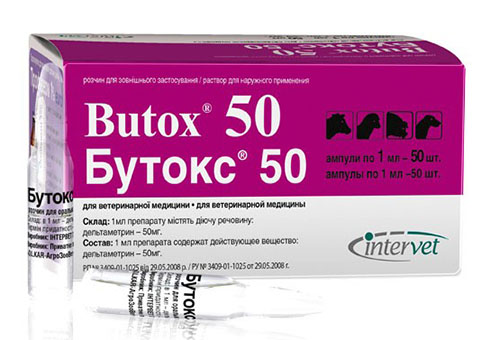
- 0.2% alugan solution.
To other means fight against growths on the surface of the paws in chickens include:
- Use heated to 40 degrees C Vishnevsky ointment or birch tar with immersion of the paws of chickens in a special bath with heated liniment, at a level below the surface of the moldy joint and holding in the composition for several minutes. When carrying out this and other procedures involving the immersion of the bird's paws in the drug, it is necessary to exclude the possibility of the bird swallowing the drug, for which, when performing it, the animal should be held by the head and legs.
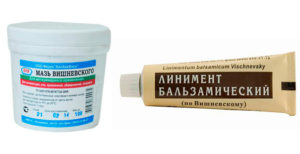
- Application of neostomazan, from which an emulsion is prepared, having a 0.2% concentration, after which the composition is heated to a temperature of 40 C, with further filling of the prepared container with the drug and keeping the paws of chickens in them for 3-4 minutes.
- Treatment of affected areas 0.5% emulsion of neocidol or ectosan, As a rule, it is carried out by spraying to increase the degree of penetration of the smallest particles into the area of the damaged cells of the dermis.
- Good results are characterized by the use of drugs from the group to combat parasites ivermectins, solutions on the basis of which they are prepared, depending on the recommendations specified in the instructions for use of drugs such as brovermectin, vetamectin other.
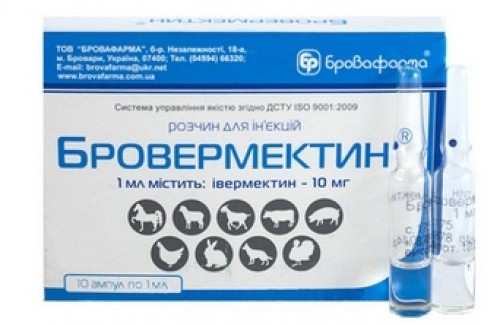
In addition to medications, the elimination of parasites from under the surface of the skin, growths on the paws of chickens with high efficiency can be carried out using one of traditional medicine methods:
- One way to kill an itch mite is 3 week treatment of the damaged area in the evenings with warmed sunflower oil.
- An even more effective remedy is adding one spoonful of solid oil to 150 ml of heated oil, bringing the mixture to a homogeneous state and processing the places of localization of parasites. The action of this tool is based on the complete restriction of oxygen access for ticks, which leads to their death.
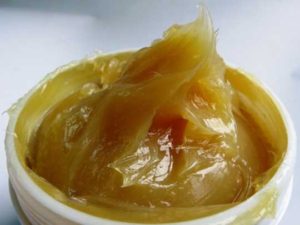
- Good results are provided by treatment of damaged areas with soapy water, which is performed by immersing the legs of the bird and soaking in the emulsion for 30 minutes. After that, the places of localization of parasites should be processed birch tar or 1% creolin solution.
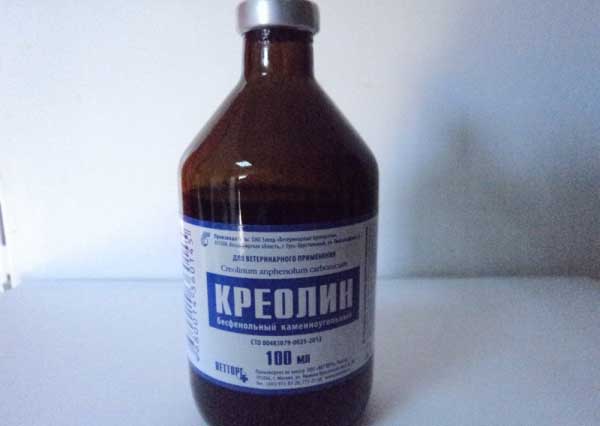
By the way! Any of the described procedures used to treat scabies mites in birds are performed several times, the interval between which should be from 1 to 1.5 weeks. For preventive operations, it is enough to use a single treatment of growths on the paws of chickens.
In addition to processing poultry, a set of measures to ensure the destruction of the scabies mite includes cleaning the chicken coop with the removal of droppings and litter. After that, all surfaces of the room are thoroughly washed with a soap solution, followed by spraying with a solution based on an acaricidal preparation.
Video: treatment of growths on the paws (knemidocoptosis) in chickens
Prevention of the appearance of growths in chickens
To prevent the appearance of growths on the legs of chickens, you can compliance with the recommended regimes for keeping poultry, with the help of a systematic examination of the livestock and the timely detection of individuals with signs of pathology. However, not all of them are manifestations of knemidocoptosis, some are caused by physiological features of the chicken body structure, some of them are caused by diseases such as pasteurellosis, coccidiosis, psittacosis, arthritis or tendovaginitis. Nonethelessconsiderate behavior or health changes in the bird is the most effective measure to prevent infection.
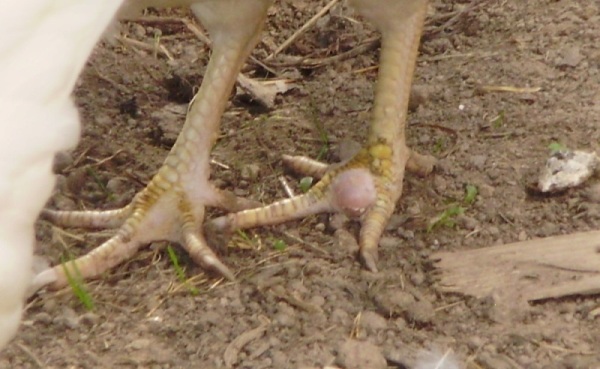
Thus, growths on the paws of chickens arise as a result of a violation of the conditions of detention, with an unbalanced diet, deviation of the room humidity from the recommended values. As a result, on the surface of the skin of chickens there are favorable conditions for colonization with parasitic forms, for example, scabies mites. The presence of parasites in the body of chickens has a negative effect on appetite, which in turn has an effect on a decrease in bird productivity. A set of measures aimed at getting rid of growths in chickens includes the use of medicines and folk remedies with simultaneous treatment of the room with acaricidal preparations.

